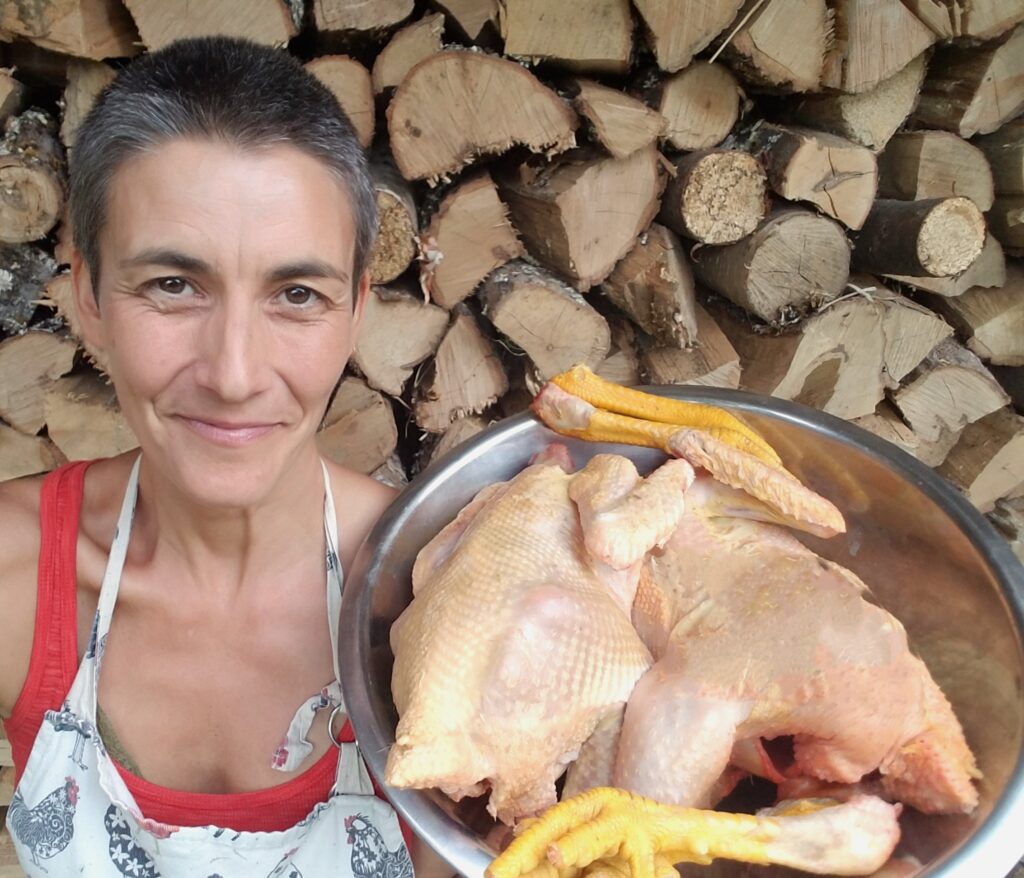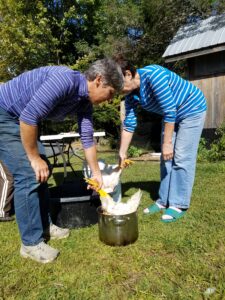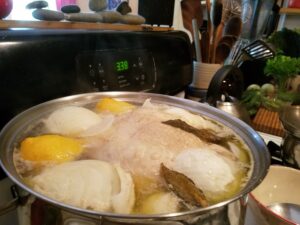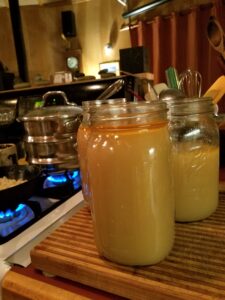Rooster Stock Recipe
Tara Carpenter, NC.
Nutrition Consultant specialized in helping people regain gut microbiome after yeast, bacterial, and viral infections.

Originally published on September 19, 2019.
Rooster stock, like any meat stock, is mineral-rich to strengthen immunity and support digestion. Stock also contains collagen to strengthen and keep tendons, joints, ligaments, bone, hair, and skin supple. The collagen in stock is traditionally known to heal the gut lining in order to relieve heartburn, GERD, and intestinal inflammation.
When I was growing up, my mom always had a pot of soup simmering on the stove. She would put a whole clean chicken in there with a rough-chopped onion, handful of carrots and same with celery stalks, a few garlic cloves left whole, tied up herbs, and bay leaves. The whole thing would then get topped off with cold water and there it would sit on the back burner for hours on end. My bedroom, which sat over the kitchen, would literally be consumed in rich smells wafting up through the floorboards!

No matter where life takes us, the kitchen is where we return.
As a mom myself now, I make a gallon of meat stock once or twice a week depending on the season we are in and what kind of meat-on-bone is in the fridge/freezer. As a family, we go through stock fast in the winter as I serve mugs of hot stock with most meals, often with a pastured eggs that are scrambled in along with minced fresh dill. Always hits the spot and great for the digestive tract lining (mouth to anus)!
More benefits of meat stock is here.

This year we had more roosters in our flock then we could manage. Mainly, they were beginning to cause problems and after unsuccessfully trying to rehome them, we took a day to slaughter, gut, and de-feather them one-by-one until done. I was fortunate to take two home to make stock which I turned into the recipe below for public sharing.


Rooster Stock Recipe
Makes: about 4 quarts
Ingredients
- 4-8 lb. whole, pastured rooster with head and feet attached if possible, plucked and gutted (or equivalent weight in bony parts using only neck, back, breastbone, wings, joints).
- Gizzards from one rooster (optional)
- 2-4 rooster feet, scalded in boiling water and peeled, chop off nails if long and dirty (optional)
- 6-12 eggshells, cleaned (optional)
- 4-8 quarts cold filtered water
- 2-3 Tbs. acid (i.e., raw apple cider vinegar, lemon) *
- 1 large onion, peeled and chopped
- 3 large carrots, chopped
- 4 celery stalks and handful of leaves, chopped
- 1 bunch parsley
- 4 cloves garlic
- 1-inch fresh ginger
Instructions
Remove gizzards from cavity as well as the wings and neck – If bird head is intact, keep it there – all the better for stock.
Place rooster or bones in a stainless steel/ceramic pot with all but parsley, garlic, and ginger and allow to stand for 30-60 minutes.
Bring to a slow, gentle boil – removing any scum that rises to the surface (Chinese specialty stores sell a great fine skimming spoon!); reduce heat, cover, and simmer DON’T BOIL for about 4 hours.
Remove whole rooster from pot onto large plate and let cool to handle. Separate meat from bones. Skin, cartilage and strips of rubbery meat can go to dogs, etc. The meat will slip off bones easily. I set meat aside to make a stew with and put rest in fridge for sandwich meat and cooked dishes (if using bones only, skip this step and leave everything to simmer 6-24 hrs.).
Place bones and legs back into pot, which is still on low flame heat, add sea salt to taste, put lid on, and simmer another 4-20 hrs.**
Add parsley, garlic, and ginger in final half hour for flavor and minerals.
Strain stock into wide-mouth glass Mason jars that do not have cracks in them! I place jars on a kitchen towel laid inside a bowl – before filling – in case one has a hairline fracture. Can also pour into another pot. Either way, cool slightly before placing in fridge. A layer of fat will coagulate to top and harden as stock gets cold***. Stored this way, stock keeps longer.
Screw on a fitting lid when inside of jar is completely cool otherwise moisture can rise above fat and cause mold. I like to open these jars the day after I close them in order to dry off inner top lids with a paper towel.
Store in fridge up to 1 week or freeze up to 3 months.

Wrap extra rooster feet +roosters!) in freezer paper in a Ziploc bag and freeze.

Tips & Tricks
- Ideally, keep the head on to add more nutrients to the pot of stock.
- Roosters are known to be more tough especially as they mature past 12 weeks or so of age. Basically the older the rooster the tighter the muscle fibers in meat. By letting the whole dressed rooster sit and age in fridge, allows the muscle fibers to relax and tenderize. To “age bird”, cover loosely with wax paper (not plastic wrap as needs to breathe) and place in fridge 2-7 days before cooking.
- Rooster feet are gelatin-rich and worth effort to source. Purchase from local butcher, farmer, or freerangechicken.com. I like to use 2 feet per gallon of water.
- Substitute another meat on-bone for rooster (i.e., lamb, deer, beef) …. note that beef bones are dense and may cook up to 72 hours.

*Soaking bones in an acid prior to cooking leeches more valuable minerals (calcium, phosphorous, sulphur) from the bones and puts them into your stock which eventually gets into your body and will be a more mineral-rich version 
**Cook 6-8 hrs. only if you are in the beginning stages of healing your digestion with stage 1 of B.E.D. As digestion improves, you can cook bones longer without worrying about irritating your gut. Keep in mind that stock cooked longer than 24 hours can acquire an “off taste” (unless using dense bones as you find with cows).
***Fat that rises to the top acts as a preservative for the stock below. I leave this layer alone until I am ready to use the stock because the fat helps seal out incoming bacteria from the air. When ready to use, I cut a pie slice into the fat and dip in with a long-handled ladle. You can also pour it out. If you have a hard time digesting fat then skim off the very top layer (not all the way down, otherwise you will get moisture liquid caught up in the fact and more likely to mold in fridge – won’t store as long. Place this in a small glass jar to use in small amounts for sauteing vegetables, etc.

References
Bauman, D. (2011). Homemade Stock Is Full Of Minerals. Retrieved at https://indianapublicmedia.org/eartheats/homemade-stock-minerals-every-dish/
Campbell-McBride, N. MD. (2011). Gut and Psychology Syndrome. Soham, Cambridge; Medinform Publishing.
Fallon, S. (2010). Nourishing Traditions. Bogart, GA: B.E.D. Publications.
Mercola, MD. (2013). Bone Broth – One of Your Most Healing Diet Staples. Retrieved at https://articles.mercola.com/sites/articles/archive/2013/12/16/bone-broth-benefits.aspx
Paleo Diet Lifestyle (2011). Making Fresh Bone Stock. Retrieved at https://paleodietlifestyle.com/making-fresh-bone-stock/
May all bellies be happy!


3 replies on “Rooster Stock Recipe”
Thanks so much for sharing our post! Great website here!
Jenneta,
That is a great question.
I typically recommend people start taking bone stocks and more saturated animal fat once they’ve made progress in balancing gut flora and are able to digest fats properly.
Yet, meat stocks (which are milder than bone stock) can be used while healing gut dysbiosis, especially if one has a leaky gut (where the intestinal lining is permeable).
Meat is highly recommended in the early stages of healing gut flora imbalances, yet this food can be tough to digest for those with dysbiosis. That said meat stocks can be made and carefully strained of the cooked saturated fat that rises to the top.
Bone stock provides amazing properties and fuel for the intestinal cells, helping to close up gaps in a leaky gut. Glutamine, also found in bone broth, is important metabolic fuel for cells in the small intestine. All said bone stocks and animal fats are wonderful to move towards as soon as you are able.
During stage 1 of healing gut flora imbalances you can experiment with small amounts of easier to digest fats such as cultured, raw butter; ghee; coconut oil; fermented cod liver oil; egg yolks; young green coconut “pudding”; goat/cow milk kefir (if tolerated); wild salmon; sardines; olive oil; olives; avocado; X-Factor Butter Oil (Green Pasture); and other healthy fats such as soaked nuts and seeds.
Lamb makes a nice meat stock that is gentle, soothing and full of healthy fats and using lamb stew meat can usually be tolerated by those healing the gut in the initial stages.
Tara,
thanks for the recipe. I am confused about rendered fat benefits to heal the gut. Donna says that cooked saturated fats may feed pathogenic flora in an unhealthy digestive system, thats why I have been tossing the fat lately. What is your thought on this? Personally, I love dishes made with animal fats because I grew up eating meals made with them.
Thank you,
Jenneta